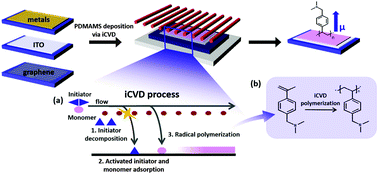Tuning the electrode work function via a vapor-phase deposited ultrathin polymer film†
Abstract
In organic electronic devices, the capability of controlling the work function (WF) of electrodes is crucial in order to facilitate charge injection/collection. In this work, we introduce a new method to improve the electron injection characteristics of electrodes by depositing an ultrathin, electron-donating polymer layer, poly(dimethylaminomethyl styrene) (PDMAMS), via initiated chemical vapor deposition (iCVD). The deposition process enabled the ultrathin PDMAMS layer to be coated on top of the electrode surfaces with a wide range of hydrophilicity, without requiring any surface pretreatment. WF reduction was observed in various electrode materials including Au, Cu, indium tin oxide (ITO), and graphene surfaces, due to the strong electron donating property of the polymeric layer. The newly integrated WF-controlled Au and Cu electrodes were applied to organic thin film transistors (OTFTs), and a substantial improvement in electron mobility (from 4.75 × 10−6 cm2 V−1 s−1 to 0.89 cm2 V−1 s−1) was observed, due to the facilitated electron injection from the modified air-stable electrodes. The ultrathin layer was also coated onto the ITO cathode of inverted organic solar cells (IOSCs), resulting in around 3.5 fold improvement in the device efficiency. Furthermore, an effective n-type doping of graphene was successfully demonstrated where the Dirac point of graphene systematically shifted after the film deposition, which enabled the production of a graphene inverter with distinct on/off configurations. Since the iCVD can be used to form ultrathin films free of dewetting issues, deposition of ultrathin PDMAMS via iCVD can be a new powerful method to control the interface of various electrodes and the active channel for organic electronics.


 Please wait while we load your content...
Please wait while we load your content...